If you were to
take the story of Cinderella and replace the fairy godmother with
grace, the goings-on with the pumpkin and mice with actual miracles,
and the prince with
Christ, you'd have the story of St. Germaine Cousin.1
Germaine was born in 1579, in a little hamlet near the town of Pibrac,
in the Languedoc-Gascony area of southwestern France that is now known
as the Haute-Garonne. To find it on a map, know that Pibrac is a little
over 9 miles west of Toulouse, the city in which St. Dominic founded
the Dominican Order and received the rosary
from the Blessed Virgin.
From the very beginning, Germaine's life was marked by suffering: she
was born with a deformed, practically useless hand, and, very
early on, came down with "the king's evil" -- scrofula, a disease that
causes swelling of the lymph glands, especially in the neck.2
Untreated with antibiotics, these swellings can become abcessed,
oozing, and painful. To compound her miseries, her mother died when she
was very, very young.
And then things got even worse: her father married a woman who had
daughters of her own, girls she much favored over Germaine, whom she
treated with contempt. Using the
excuse of keeping her girls safe from scrofula, she moved Germaine from
the house to the attached stable and put her to work as a shepherdess
and spinner of wool at a very young age. Imagine
living in what amounts to a barn, without even fire for warmth
during winter, and then being made to spin yarn with icy-cold hands,
one of which was mostly paralyzed! Even Cinderella had a fireplace to
warm herself by!
Germaine never had shoes, and was given only old, tattered clothing to
wear. In addition to these humiliations was physical abuse, with her
stepmother once even pouring boiling water on her legs in anger.
Why Germaine's father allowed this nightmarish situation is unknown;
people have
wondered if perhaps Germaine had actually been a foundling -- unwanted
and abandoned at the Cousins's doorstep -- or if, maybe, she wasn't
biologically related to her father, but was a daughter his wife had
from a previous marriage. Perhaps one of these things is true, but
nothing excuses the way Germaine was treated.
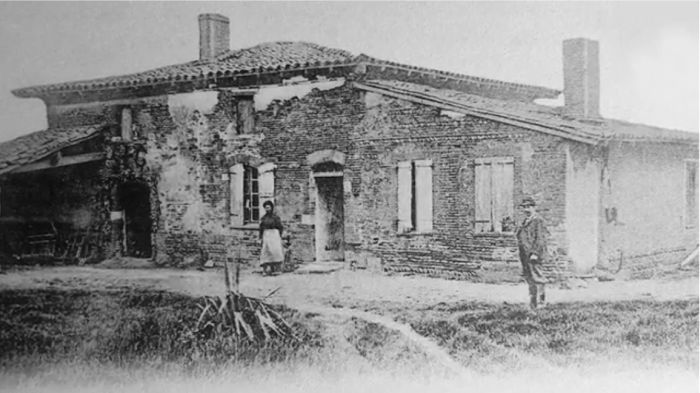 The home
of St. Germaine. The door on the left is the entry to the stable, where
the animals and St. Germaine lived.
The home
of St. Germaine. The door on the left is the entry to the stable, where
the animals and St. Germaine lived.
The door on the right is the entry to the house proper.
Sickly, frail, thin, separated from family life, and with only God, His
Saints, the angels, and her sheep for friends, Germaine didn't allow
the abuses she suffered to cause her to become bitter and resentful;
quite the opposite. She became a paragon of piety, so much so that
villagers would mock her for it -- yet another source of torment.
But she persisted in honoring God with all her might and with what
little she had. She fashioned a rosary out of the yarn she made and
would pray it often in the fields or at night in her makeshift bed
under the stairs in the stable. She would fall on her knees when she
heard the Angelus bells ring three times
each day, and would do so even if she were standing in water -- which
would not be infrequently since she attended Mass every day and had to
cross a stream to get there. She would walk with her sheep to the 13th
century parish church named for St. Mary Magdelen and,
though the area was forested and filled with wolves, she'd fix her
shepherdess staff into the ground and trust God with the care of her
lambs while she attended Mass. And no harm ever came to them; not a one
was lost.
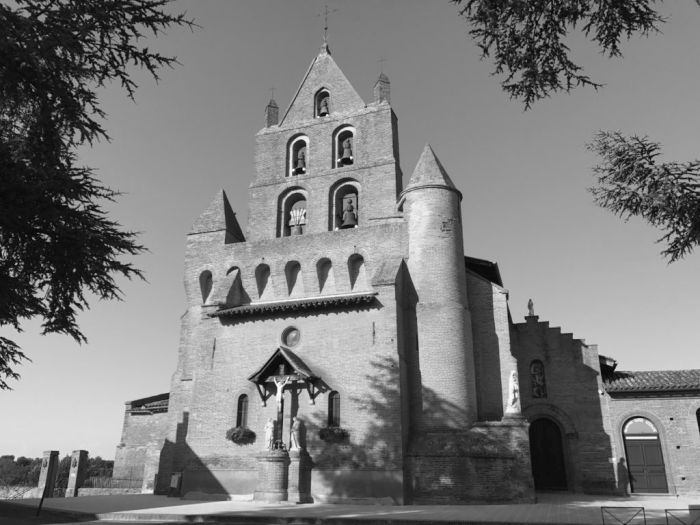
L'Eglise Sainte-Marie Madeleine, St.
Germaine's parish church
One day, after much rain, the stream that ran between her home and her
church became swollen and raging, but she walked serenely to its edge,
made the sign of the cross, and entered in,
only to have the waters part, like the Red Sea did for Moses, so she
could cross without drowning or even getting wet. This was witnessed by
villagers who then began to regard her with a newfound respect --
perhaps even awe.
But she carried on as always, with the most profound sense of God's
Presence. So humble was she that, in spite of abuses that would cause
most to suffer from a burning sense of resentment and desire for
revenge, her prayer was, simply, "Dear God, please don't let me be too
hungry or too thirsty. Help me to please my mother. And help me to
please You."
She would even give what very little she had to beggars. Once, in an
event which echoes a story from the life of St. Elizabeth of Hungary,
she wrapped bread in her apron to take to the poor, but was
stopped by her stepmother who accused her of stealing the food. She
threatened to beat Germaine, and was hurling abuses at her when two
villagers intervened to protect the girl. The stepmother again accused
her of theft and ordered her to open her apron and show what it
contained -- and when she did, beautiful flowers spilled out.
After years of neglect, her father came to repent of the abuse his
daughter endured.
Realizing the evils that had been committed against her, he invited
Germaine back into
the house, but she declined the offer, telling him that she was
content among the animals.
Thus she lived her life alone -- quietly, humbly, and full of love for
God and neighbor as Lord Christ commands and as St. Matthew records in
chapter 22 of his Gospel:
Master, which is
the greatest commandment in the law?
Jesus said to him: Thou shalt love the Lord thy God with thy whole
heart, and with thy whole soul, and with thy whole mind. This is the
greatest and the first commandment. And the second is like to this:
Thou shalt love thy neighbour as thyself.
And then, in 1601, God took her home -- but not, so the story goes,
without granting to the world another sign that St. Germaine is someone
to emulate and take as a friend: on the night of her death, two monks
who were on their way to Pibrac saw young girls in white and surrounded
by a golden light descend from the skies and then walk toward the
Cousins' house. Then, a bit later, they saw the girls again -- this
time accompanied by yet another girl in white who was crowned with
flowers -- ascending into the heavens. A Gascon priest travelling from
the opposite direction had the same vision. The next day, they related
what they saw
to villagers in town, and they all seemed to intuit the meaning of the
vision, so they gathered at the Cousin house only to find that Germaine
had died there on her bed of vines and twigs underneath the staircase
in her stable, among her sheep. She was discovered by her father that
morning when she failed to show up to tend the
flocks. When he found her, her yarn rosary was in her hands.
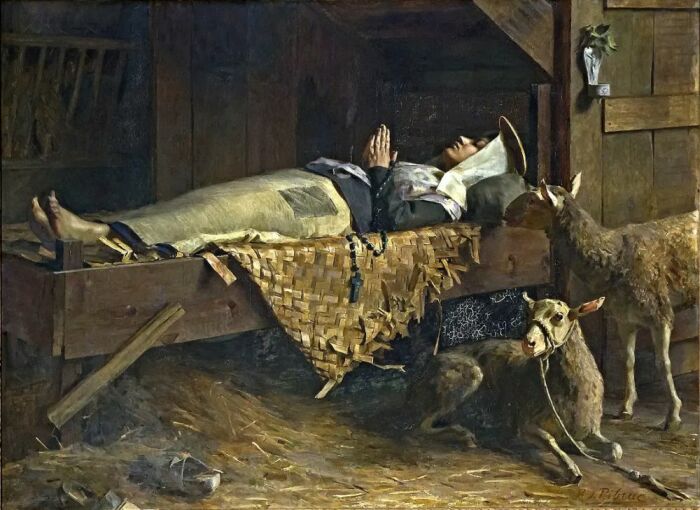
She was buried, unembalmed, in front of the pulpit of the same church
at which she attended Mass each day, and was apparently forgotten for a
time.
Then, a little over forty years later, in 1644, her grave was opened so
that the body of one of her relatives could be buried there. When her
body was uncovered, it was found to be as fresh as the day it was laid
to rest. Her body was displayed to the public, prayers went up, and
miracles began to happen in great abundance, the first of these being
the cure of a woman's infant son who was expected to die. In gratitude,
the woman purchased a lead coffin to hold St. Germaine's body. This
casket was moved to the sacristy, and when opened again in 1661, her
body was still found to be intact. Wanting to be more sure about this
sign of possible sanctity, the priest had the area around the pulpit
dug up to determine the state of other bodies buried there, and found
that only St. Germaine's was intact.
In 1700, her lead casket was opened again with the same results. The
cause for her beatification was begun, but was stalled for a time --
and then came the
demonic French Revolution, which left not even St. Germaine untouched.
In 1793, revolutionaries threw her body into a pit and poured quicklime
over it, destroying some of it. But what remained was salvaged, praise
God. It's said that the revolutionaries were three in number, and that,
after committing their evil, all three were almost immediately struck
by bodily infirmities, with one never repenting, and the other two not
only repenting, but being cured through St. Germaine's interecession.
Things settled down in France, and the cause for her beatification was
resumed in 1850. The Catholic Encyclopedia tells us that the
documents
attested more than 400 miracles or extraordinary graces, and thirty
postulatory letters from archbishops and bishops in France besought the
beatification from the Holy See. The miracles attested were cures of
every kind (of blindness, congenital and resulting from disease, of hip
and spinal disease), besides the multiplication of food for the
distressed community of the Good Shepherd at Bourges in 1845.
She was finally canonized on June 29, 1867. Her reliquary -- now no
longer made of lead, but of a more precious and beautiful metal --
remains in the little church in which she was interred, but some of her
relics were later moved to a lovely Romano-Byzantine basilica that was
built
in Pibrac in her honor -- la Basilique Sainte-Germaine.
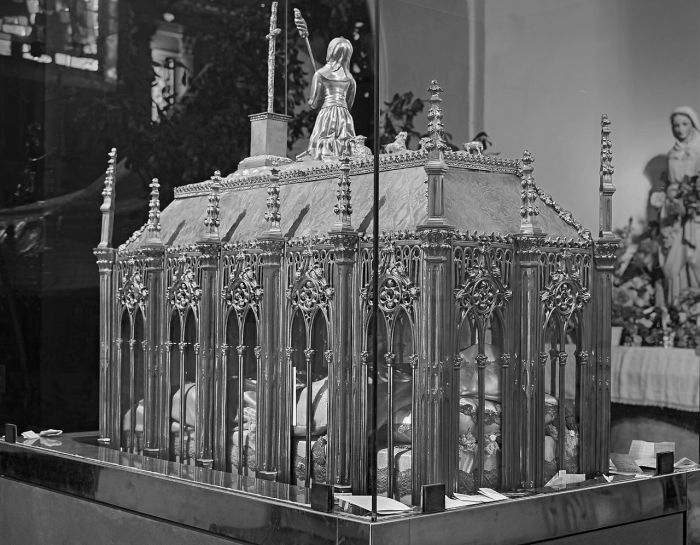 St.
Germaine's reliquary St.
Germaine's reliquary
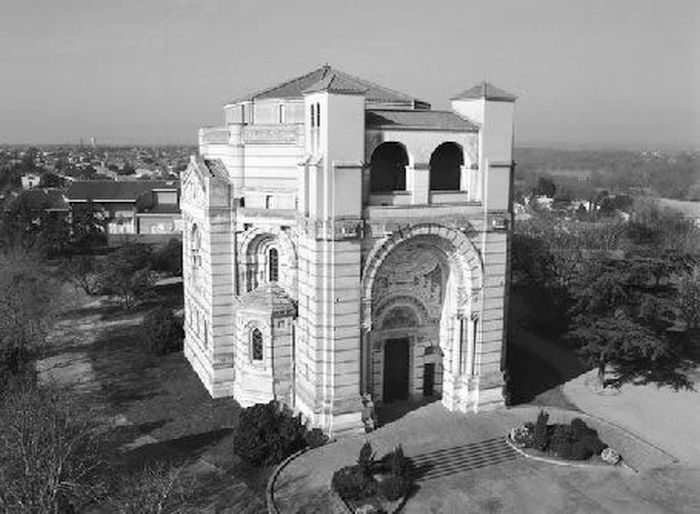
La
Basilique Sainte-Germaine in Pibrac
Pibrac has
become a great place of pilgrimage, and
every year on June 15, her feast day, her relics are processed from
l'Eglise Sainte-Marie Madeleine to the la Basilique Sainte-Germaine.
Then a pilgrimage is made to the house in which St. Germaine's family
lived, and the little stable in which she devoted herself to God and
attained holiness. Along the way, the Way of
the Cross is made.
St. Germaine -- "la bergère au pays
des loups" ("the shepherdess in the country of wolves") as the
playwright Henri Ghéon called her -- is the patroness of the weak,
abused, sick, disabled, poor, and shepherds. She's portrayed in art as
a young woman with her
sheep, a shepherd's crook, a distaff, and/or flowers.
Customs
A prayer for the day is a translation of a French one:
Remember, O
sweet Germaine, your brothers and sisters who groan and who
suffer in this vale of tears. Remember those who hope in you, who await
your help with their trials, your consolation in their sorrows.
Remember that you, too, groaned, that you, too, cried, that you,
too, knew poverty, isolation, humiliation, and suffering. And now, in
your glory, remember our miseries; in your power remember our
infirmities; in your happiness, remember our tears. Teach us, in your
school of sweetness, of your patience, your faith, and your love. Then,
at our deaths, receive us into our eternal home.
Or there is the Litany to St.
Germaine Cousin de Pibrac, written by the uncanonized,
controversial
Bretonne mystic Marie-Julie Jahenny (1850-1941).
There is no special music or food associated with her feast that I know
of; St. Germaine is not as well known as she should be outside of
France, alas, so we in other parts of the world can come up with our
own practices that may become traditions in the future. Perhaps you can
read to your children the story of Cinderella, then tell them the story
of St. Germaine, asking them to find the similarities. The story as
told by Perreault: Cinderella
(pdf)
But most important today is learning the lessons of St. Germaine's sad
but awe-inspiring life, and pondering the bliss she is enjoying now in
Heaven. Consider how spoiled most of us are, how devoted to pleasures
and to self. We parade ourselves on the internet, constantly looking
for attention. We wallow in resentments and pettiness, and act on our
sinful envies. And then there is St. Germaine, whose sufferings most of
us can't begin to imagine, but who lived a life of such grace and
beauty that almost all the world is put to shame in comparison. Asking
God to make us more like her is absolutely the best use of the day.
Footnotes:
1 She is mostly known as "Sainte Germaine
de Pibrac" in France. Her name, in any case, is pronounced "Zher-men
Coo-zaih" -- where the N in "Cousin" is not pronounced, and the final
vowel sound is kind of similar to the vowel sound one makes when saying
"wah" as in a mocking crying sound.
2 Scrofula is now usually called
lymphadenopathy, and is caused by bacterial infection, including
infection by the
bacterium that causes
tuberculosis. In medieval times, it was thought to be cured by the
touch of the reigning monarch. This practice in England goes back to
since at least Henry I, and in France to at least King St. Louis IX.
In England, the monarch would touch the neck or face of the afflicted
and hang a coin around his neck while offering prayer to God, to the
Blessed Virgin and other Saints, and citing Sacred Scripture (Mark
16:14-20 and John 1:1-14).
|

